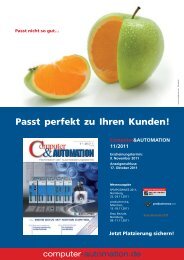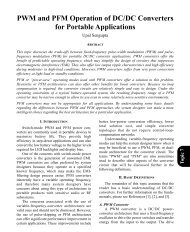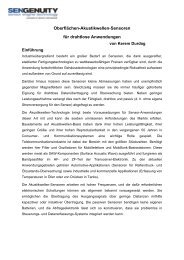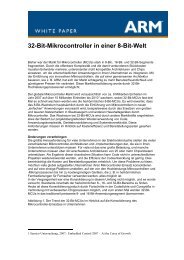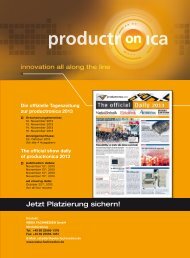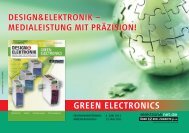Power Factor Correction Demystified - Energie & Technik
Power Factor Correction Demystified - Energie & Technik
Power Factor Correction Demystified - Energie & Technik
Create successful ePaper yourself
Turn your PDF publications into a flip-book with our unique Google optimized e-Paper software.
www.microchip.com<br />
Reactive power doesn’t do any useful work, but it is required to maintain and sustain the<br />
electromagnetic field associated with inductive elements and loads. Reactive power is<br />
expressed in Volt Amperes Reactive (VAR) and is registered on the electric meter at the<br />
utility company in kilo Volt Ampere Reactive (kVAR). The total required power capacity,<br />
known as apparent power, is expressed in simply kilo Volt Amperes (kVA).<br />
Using the above power components, power factor is a parameter that can be defined as the<br />
amount of working power used by a system, in terms of the total apparent power. Ideally, the<br />
power factor for a given system should be unity. However, in actual systems, the power<br />
factor deviates from unity for the following reasons:<br />
Phase shift of current with respect to voltage, which results in displacement. This is<br />
sometimes called the “Displacement <strong>Factor</strong>.”<br />
Harmonic content present in the current that results in waveform distortion. This can<br />
be termed as “Distortion <strong>Factor</strong>.”<br />
Now, power factor can be alternatively defined as the product of distortion factor and<br />
displacement factor. <strong>Power</strong> factor becomes an important measurable quantity and a figure of<br />
merit because it often results in significant economic savings for utility companies.<br />
The objective of PFC is to make the power converter present itself as a linear resistance to<br />
the input voltage. If the input voltage has a sine-wave shape, the input current will also have<br />
a sine-wave shape. This allows the power distribution system to operate more efficiently,<br />
thereby reducing energy consumption.<br />
Cause and Effect of Current Harmonics<br />
Current harmonics are sinusoidal waves that are integral multiples of the fundamental wave.<br />
They are altogether different from line disturbances, such as transient distortions and power<br />
surges. Current harmonics appear as continuous, steady-state disturbances on the electric<br />
network.<br />
Some of the common causes of current harmonics are:<br />
<strong>Power</strong> electronic equipment, such as rectifiers, Uninterruptible <strong>Power</strong> Supplies<br />
(UPSs), state converters, thyristor systems, Switch Mode <strong>Power</strong> Supplies (SMPSs)<br />
and SCR-controlled systems, among others.<br />
Commonly used industrial equipment, such as welding machines, arc furnaces, and<br />
mercury vapor lamps.<br />
Saturable inductive equipment, such as generators, motors and transformers.<br />
The problems caused by current harmonics include:<br />
Erroneous operation and nuisance tripping of system components, such as circuit<br />
breakers, fuses and relays.<br />
Damage to sensitive electronic equipment.<br />
Excessive overheating of capacitors, transformers, motors, lighting ballasts and other<br />
equipment.<br />
Interference with neighboring electronic equipment.<br />
To reduce these harmful effects, the current drawn from the input needs to have a similar<br />
shape to that of the input-voltage profile.



